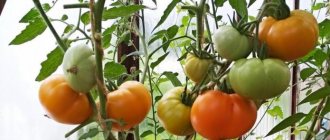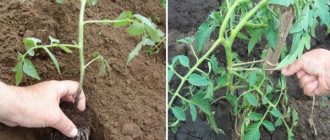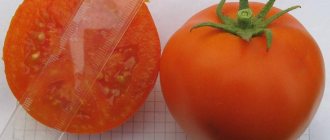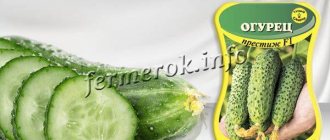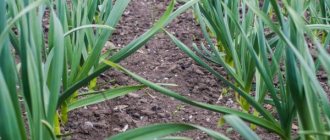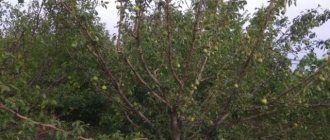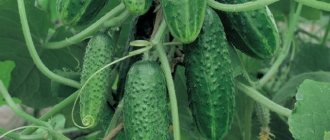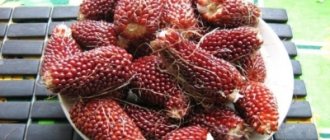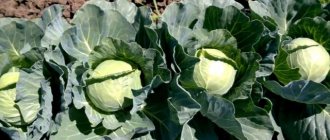Origin of tomatoes
The history of the variety begins in 2008, when the agricultural company decided to diversify its assortment and please lovers of a good harvest with new tomatoes. In the same year, “Ladies’ Man” was included in the state register, after which the cultivation of a tomato of amazing quality began in all regions of the country.
Ladies' man pepper: seeds and fruits
Pepper seedlings Ladies' man
Ripening Ladies' man pepper on a bush
Description and characteristics of the Ladies' Man
Before choosing this variety for planting in your dacha, you need to study its description and characteristics. We will talk about them further.
Description of fruits
If we talk about fruits, they are always of an elongated cylindrical shape, which tomato growers themselves simply call pepper-shaped with a pronounced “spout.” The skin is smooth, has a small thickness and a beautiful glossy tint, which makes tomatoes a truly attractive fruit.
A ripe tomato has a bright red color without unnecessary spots or tints, but an unripe fruit will be simply green without the characteristic spot near the stalk of many tomatoes.
The pulp itself is soft, tender and quite meaty.
Basic qualities of fruits
Due to its low dry matter content, “Ladies' Man” retains its juices and original shape when cut and does not release excess liquid, so the tomato is used both for salads and as a fruit for canning.
The taste is such that sweetness is combined with a slight sourness. The tomato has only 2 seed chambers, which are not large in size or have a significant number of seeds.
“Ladies’ man” cannot be called large-fruited, since its standard parameters are 45-60 g.
The resistance to cracking is quite high, so they cope well with transportation, maintaining their original shape even after a long journey.
Productivity
"Ladies' Man" is distinguished by its high yield. According to statistics from experts, the standard yield per square meter is at least 10 kg. However, such results can be achieved only with the correct planting technique and timely, and most importantly, competent care.
Advantages and disadvantages
Like any other variety, “Ladies’ Man” has both certain advantages and significant disadvantages that should be taken into account at the stage of familiarization and selection. Of the main advantages, it is worth noting the following points:
- high yield - with the right approach, you can get a maximum of fruits (about 10 kg per 1 sq. m);
- resistance to temperature changes - the variety can be grown in different climatic zones, since it is universal in this regard;
- according to GOST, the taste of the fruit is excellent;
- tomatoes are actively used for fresh consumption and canning;
- tomatoes do not crack and withstand long-term transportation well, making them suitable for growing on farms;
- when cut, tomatoes do not release excessive amounts of juice;
- Compared to competitors, they are quite easy to maintain.
If we talk about the disadvantages, then the main ones are these characteristics:
- the presence of voids - they are small, but for some this is a problem;
- Doesn't really like a lot of sunlight.
Tomato Auria (Maleness): photos and features of the variety
| Ripening period: | mid-late |
| Shape, weight of fruits: | pepper, 100-150 g |
| Bush type: | indeterminate |
| Growing regions: | greenhouses - all regions, open ground - southern Russia |
| Productivity: | 5 kg per bush |
Tomato Auria is one of the most popular exotic varieties. Moreover, it is famous not only for the strange shape of the fruit, but also for its yield, excellent taste, and complex resistance to diseases. Despite the fact that the variety has become widespread in different countries, and the seeds are sold even through eBay and Amazon, its origin is vague.
Foreign catalogs usually indicate Ukraine as the place of creation; in the post-Soviet space, the tomato is often positioned as Israeli. Perhaps those closest to the truth are those who consider the variety to be a particularly successful example of folk selection.
Characteristics and description of the variety
In addition to the official name, Auria tomatoes can be found under the names: Male Dignity;
Sometimes the Zabava tomato is included in the list, but this is a separate variety, although it looks similar to the one in question.
When describing a variety, they always point to liana-like shoots. They are really long, thin, bend well and can withstand loads. Typically, tomatoes form the trunk themselves, at the initial stages of development, which makes care easier.
The first fruit cluster is laid above the 10-12th leaf, the subsequent ones appear every 2-3 internodes. The lower ones contain 6-8 ovaries, the upper ones can consist of 2-3 tomatoes. During the growing season, 5-6 clusters can fully ripen; there is no point in preserving the rest.
Among the characteristics of the Auria variety, one should note the very long, thin, articulated stalks. They seem fragile, but support the weight of the tomatoes well.
Tomatoes Women's Joy are red, have a characteristic shape, really similar to the male reproductive organ. The fruits are classified as pepper-shaped. But the characteristic shape of the Auria tomato also has a commercial name - banana-shaped.
This means that the fruits are asymmetrical, not aligned in length or thickness, and may bend slightly.
The Male Dignity tomato has pronounced swelling, which is clearly visible in the photo, and does not spoil the appearance, but adds piquancy to it. The nose is pressed inward and appears forked.
The length of the tomatoes reaches 12-14 cm with a diameter of 3 cm. The average weight of the fruit is 100-150 g; larger and smaller tomatoes can be found in the bunch.
Tomatoes have 2 chambers, few seeds, dense but juicy pulp. It is often used to make tomato paste and sauces. The fruits fit easily into the jar and are convenient to eat. This makes the variety ideal for whole canning. According to reviews, tomatoes have an excellent aroma and taste. They are good in sliced vegetables, salads, and served whole.
The yield is about 5 kg per bush. This is a good indicator for pepper tomatoes. The variety is transportable and lightweight.
Timing of sowing seeds
Tomato Male Dignity medium late. From the appearance of friendly shoots to the ripening of the first fruits, at least 110 days pass. The time period from the moment of sowing the seeds to transplanting into a greenhouse or soil is 60-65 days.
Auria tomatoes are placed in beds exclusively in the southern regions, when the ground warms up to 15° C. Usually this happens no earlier than the beginning of May. In other regions, the variety can only be planted in a greenhouse, otherwise the fruits simply will not have time to ripen. The optimal time occurs when the soil warms up to 10° C.
Based on this, the timing of growing seedlings in different regions should be calculated:
- in the Moscow region and the Center, tomato seeds Manhood should be sown from mid to late March;
- North-West, Siberia, Ural - late March or early April;
- southern regions - for open ground mid-to-late February, or 2 weeks earlier to plant tomatoes in greenhouses.
The weather in Siberia and beyond the Urals is unpredictable. Auria tomato seeds are sown there at the same time as for the Leningrad region. But gardeners need to be prepared that the planting material will outgrow - thaws are often replaced by cold snaps, and the deadline for moving to the greenhouse is delayed.
Seedling growing method
Purchasing seedlings is a rather expensive process, and no one knows whether the seeds were grown correctly and whether all care rules were followed. If they have extra time, gardeners prefer to grow seedlings on their own, but you need to understand that “Ladies’ Man” requires a serious approach and careful care.
Seed preparation
The first step on the path to a big harvest will be preparing the seeds. If they are purchased from the manufacturer, then disinfection is not required. In other cases, this stage of preparation must be carried out before planting.
To do this, prepare a solution of manganese and water in a ratio of 1 g per 100 ml. Wrap the seeds in gauze or a piece of bandage and place in the resulting solution for 15 minutes. Experts advise adhering to such a time frame, since the similarity of the material after planting may be greatly affected.
Next, the seeds must be washed with regular running water. Many believe that soda solution seriously increases fruiting.
In addition to manganese, you can use baking soda in a ratio of 0.5 g per 100 ml, but the material will have to be kept for a day.
For disinfection, “Fitosporin” is also used, which is diluted with water in a ratio of 1 drop (half a teaspoon, if powder is used) per 100 ml, after which the seeds are kept in it for an hour to two.
Experienced gardeners recommend using a solution based on aloe juice in a 1 to 1 ratio, since it not only disinfects, but also significantly increases the immunity of future plants. You can use aloe juice either purchased or prepared yourself. The seeds should remain in it for at least a day.
Contents and location
Place trays with seedlings in the southern part of the room, preferably on a windowsill, where the plants will receive a sufficient amount of natural light. If this is not possible, then you need to worry about purchasing phytolamps that will replace sunlight.
It is recommended to combine two light sources at once (sun during the day, lamps in the evening) so that the plant is fed with light throughout the day for the first 3-4 days. On the fifth day, you can reduce the amount of time spent in the light to 16 hours a day.
For seedlings, it is necessary to maintain a temperature of 18 to 25 degrees during the day and from 12 to 15% at night. In order not to worry about the temperature, it is better to place the seedlings close to the battery. This way they won't freeze.
Seed planting process
Before planting, you need to disinfect the soil. To do this, it is kept in the oven for 10 minutes at a temperature of 200 degrees or disinfected with boiling water. After disinfection, at least 12 days must pass before planting.
For planting, you can use any container, be it peat pots or cassettes. Half the container needs to be filled with soil, then watered with soil, and then small grooves 1 cm deep must be made.
Leave a distance of about 1-2 cm between the grooves. If the container is quite large (let’s say a box), then the distance can be increased to 3-4 cm. Next, plant the seeds, add a little soil and moisten the soil again.
There is another planting method. With it, the seeds are laid out in rows, and then sprinkled with soil. It is important to moisten the soil before and after planting, but the main thing is not to overdo it with moisture.
After these manipulations, cover the seedlings with cling film, a cut plastic bag or glass to fit the container. Thus, high humidity is maintained and the microclimate is maintained, and the film allows light to pass through.
Find out the pros and cons of planting seedlings in peat pots from the video below:
Watering
Maintain high humidity, but this should be done not by watering, but by using a spray bottle. Spraying is carried out twice a day, but if you don’t have free time, you can use a humidifier.
It is important that the humidity temperature is at 80 or 90%.
Seedling care
Seedlings should not drown in water, but drought in the container should also be avoided. If there is excessive humidity, open the container and wait until it dries to the required level.
Sometimes mold may appear on the surface, but it is easy to combat. It is simply removed, and then the soil is treated with a solution of potassium permanganate or antifungal agents.
The temperature should be moderate without major changes or sudden changes. Too high a temperature can kill plants. The film is removed two weeks after planting. At this point, the stem should already have 2 or 3 leaves.
As the seedlings grow, you need to increase the amount of watering, temperature and light.
Transplanting seedlings into the ground
When the stem of the plant becomes thick and strong, and its growth reaches 30 cm, it is time to transplant the seedlings into the ground. It is important that during this period the seedling has 6-7 leaves, short internodes and flower clusters.
The transplantation process should be postponed in case of strong winds or excessive solar activity. Experts advise replanting seedlings on a calm, cloudy day.
The holes are placed at a distance of 30-40 cm and 2-3 cm deep, which will strengthen the root system. The soil is fertilized in advance with peat, and after planting, each seedling is watered with warm water under the stem.
Transplanting seedlings into the ground
Correctly carried out transplantation is accompanied by the rapid adaptation of tomatoes to the new substrate and their active growing season in the future. In order not to harm the plant, you should follow certain rules:
When the stem has reached a height of 15-20 cm, 5-7 healthy leaves and one brush have formed, the Ladies' Man is ready for replanting. You should also pay attention to the internodes - they should not be large. It is not recommended to replant tomatoes in too hot weather, strong gusty winds or even light precipitation. The best time to move seedlings to the site is a cloudy, cool day. The gaps between bushes should be at least 40 cm, since the variety has a very branched root system, and tomatoes growing close together can harm each other. You need to dig a planting hole about 10-15 cm deep, while the stem should not be buried more than 2 cm, otherwise it will begin to rot and the roots will not be able to fully strengthen. Before planting, the soil must be mixed with peat tablets and ash to provide greater nutritional value. You can also add a little organic matter - humus, urea. After completing the procedure, you should thoroughly water the bush at the root.
Place and soil
After the seeds are planted, they must be placed in a warm, well-lit place. A window sill on the south side is suitable for this. If your windows do not face south, then install additional artificial lighting. Fluorescent lamps work well.
In the first four days, seedlings need a lot of light for 24 hours. Then 16 hours will be enough. Seedlings love high humidity, so it must be maintained throughout the entire growth period. To do this, spray them with a spray bottle twice a day.
If you cannot water as necessary, then install a humidifier in the room. Remember that the humidity level should not be below 80%.
The daytime air temperature in the room where the seedlings are grown should be kept between +18 and +25 degrees, and at night between +12 and +15. An excellent option would be to place the seedlings next to the battery so as not to worry about it freezing.
Seedless growing method
To grow "Ladies' man" you can not use seedlings, but plant the seeds in open ground. With the right approach and care, you can get a luxurious harvest.
Open ground conditions
It is advisable to choose a place for planting that is not shaded by other plants and buildings, and it should warm up well. In open ground, water more often than is necessary in a greenhouse.
You need to understand that in a greenhouse sometimes plants do not receive enough light and this leads to a small harvest. It is important to fertilize the soil with peat fertilizers in a 1 to 1 ratio before planting.
Planting seeds in the ground
As a preparatory step, it is advisable to place the seeds in a growth stimulator, where they will remain for 8-12 hours. Thanks to this stage, the wait for seedlings will be halved and the first seedlings will sprout after 3-4 days.
Leave distances between rows from 60 to 80 cm, between seedlings 30-40 cm, and the depth of the hole should not exceed 3-4 cm. When sowing, actively moisten the soil and place no more than 3-4 seeds in the hole. After planting, the seeds are covered with soil.
This video shows how you can grow tomatoes without seedlings - by sowing in the ground:
Watering
The first watering of seedlings is carried out exclusively after the first shoots. In the first two weeks, seedlings are watered under the stem, which provides good nutrition to the root system.
If the soil dries out, the seedlings will begin to wither and will simply die over time, but daily watering should be avoided, because waterlogging leads to the appearance of fungus. For one sq. m. you need to use 3 liters of water and regularly spray the bushes with EM solution during the first week.
To make watering easier, it is advisable to use a drip system.
Harvest and storage
Ripe fruits are collected depending on the time of planting seedlings in open ground or sowing seeds. It is best to store fruits in a cool room, away from drafts and direct sunlight. Vegetable growers advise keeping tomatoes covered in boxes. Before storing tomatoes, they must be sorted and cracked fruits removed. Otherwise, there will be a possibility of infection of even healthy tomatoes.
Source
Landing technology
To obtain a good harvest, planting technology is important. Each point must be strictly taken into account so that the seeds produce a truly worthwhile shoot and please the gardener with a good result.
Selection of seedlings
If you cannot grow seedlings yourself, you can easily purchase them on the market. This process should be treated with special attention, since both in the market and in stores there are often unscrupulous sellers who deceive not only with the quality of seedlings, but even with the variety.
Buy plants that have already reached 45-60 days, and the seedlings should be of the same age for the beds, as this greatly simplifies the care process. In terms of height, they should reach at least 30 cm, have 11 leaves on each stem, leaves of a bright green hue, a stem as thick as a pencil and be in boxes.
Before purchasing, carefully inspect the leaves: if they are curled down, this indicates an excessive amount of nitrogen fertilizer.
What should the soil and soil be like?
The soil must be prepared in advance. It should be loose and at the same time flavored with peat. The soil where cabbage, carrots, onions, cucumbers or legumes previously grew is ideal for growing tomatoes.
You should not plant seedlings where eggplants, potatoes or peppers grew, as they reduce the nutrients in the soil. Soil that is neutral in acidity is required, although slightly acidic soil is acceptable if no other options are available.
Planting Tips
When planting, you should avoid shade, as the plants will not receive enough light and will simply wither over time. The variety is highly resistant to winds and cold, but at the same time loves light and solar heat.
Maintenance and care of plants
It is preparation, combined with proper care, that produces good fruits that every gardener can be proud of.
Loosening the soil and weeding
For "Ladies' Man", like most varieties of tomato, loose, light soil is important, so this procedure should be carried out after each watering. If this is not possible, then do loosening once every two weeks.
Loosening mainly affects row spacing, while weeding is carried out simultaneously to get rid of weeds. In the first month, the loosening depth reaches 10-12 cm, and after a while it must be reduced by 5-8 cm so as not to damage the roots of the seedlings.
Stepsoning
A large number of stepsons leads to the fact that the bush is overloaded and nutrition is dispersed throughout all the branches, and the fruits do not receive enough nutrients. To prevent a decrease in the quantity and deterioration in the quality of fruits, it is necessary to promptly trim off excess stems, leaving only the main ones.
The pinching procedure is carried out after watering, if excess stems become noticeable.
Garter
To have a rich harvest, gartering must be carried out without fail. It allows you to correctly position the upper stems so that the plant is easier to spray and they receive a sufficient level of light. In this case, the fruits will be at the top and will not be damaged by mechanical methods during weeding or from excess moisture in the hole.
For the first time, this procedure is carried out after 2-3 weeks. To do this, use stakes 2-2.5 m high, wooden cages of the same height, and caps made from scrap materials.
Top dressing
Fertilize in sunny weather, but if this is not possible, you need to do foliar feeding. During the growing season, you need to carry out 3 to 4 procedures. 3 weeks after planting, the first is carried out with mullein or bird droppings, the second during the flowering period with ammonium nitrate and potassium sulfate, the third two weeks later, after the second with mineral fertilizers, and the fourth during the fruiting period with superphosphate, which is sprayed on the plants.
Read how to fertilize tomatoes at the seedling stage here.
Disease and pest control
"Ladies' man" is susceptible to late blight, which causes the leaves and fruits to turn black. It occurs when there is excessive humidity or low temperature.
It is not possible to get rid of this disease, so prevention is necessary (after planting and as it grows). For this, ash, Trichopolum, copper sulfate, milk with honey, Fitosporin, Ecosil are used. In case of disease, the crop and seedlings are completely destroyed, and the land is carefully cultivated.
Mole crickets, ticks and whiteflies may also appear, but if agricultural technologies are followed, this can be avoided.
Reviews about the variety
★★★★★
Inna, 35 years old, Novgorod. I really liked the “Ladies' Man” variety for its taste.
Its fruits are elastic and moderately juicy. The salad turns out delicious. ★★★★★
Oleg, 40 years old, Moscow. I like that the Ladies' Man is not very susceptible to disease.
Growing it in a summer cottage will not cause many problems. ★★★★★
Egor, 52 years old, Chelyabinsk. On the advice of a neighbor, I bought “Ladies’ Man” to grow in my dacha.
I was pleased with the result. This is now my favorite tomato variety. I have been inseparable from him for 5 years now. ★★★☆☆
Irina, Yekaterinburg
I grew this variety for the first time, in a greenhouse. Germination is good, fruiting is abundant. The fruits are large and shaped like sweet peppers. The taste is good, but the fruits are not juicy, but somewhat dry, perhaps due to large voids. The main disadvantage, and this upset me very much, is that it is susceptible to blossom end rot; out of six bushes, four got sick; one bush had to be stripped almost bare due to disease. We treated it with calcium and potassium nitrate - nothing helped. Eight more varieties of tomatoes were planted in the greenhouse, but only this one was sick. It’s a pity, I won’t sit him down again, I didn’t like “Ladies’ Man”
Hide
Add your review
All gardeners and ordinary buyers speak positively about the variety, noting its excellent taste, high yield and resistance to diseases, as well as temperature changes.
0
0
Copy link
Resistance to adverse conditions
This variety is adapted to unfavorable weather conditions, so the plant stably sets fruit during cold spells, hot weather, and rainy weather (only the yield changes). It has good resistance to:
- tobacco mosaic virus, considered one of the most pathogenic;
- verticillium and fusarium wilt - these fungal diseases literally kill plants, clogging blood vessels and preventing the flow of water and nutrition;
- blossom end rot - although this physiological disease does not spread between tomato bushes, it can cause serious damage to the crop; resistance to it is a significant advantage.
Related article:
5 ways to use tomato tops for all occasions
This variety is not resistant to cladosporiosis - brown spot. Infection occurs mainly in greenhouses - at air humidity of 60% the pathogen does not develop. The source of infection is soil and plant debris.
